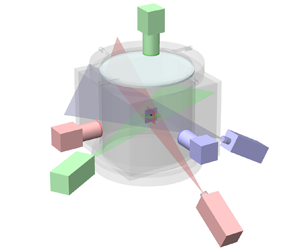No CrossRef data available.
Article contents
Experimental measurement of spatio-temporally resolved energy dissipation rate in turbulent Rayleigh–Bénard convection
Published online by Cambridge University Press: 27 March 2024
Abstract

We report a home-built velocity-gradient-tensor-resolved particle image velocimetry (VGTR-PIV) system which spatio-temporally resolves all components of the velocity gradient tensor. This technique is applied to the paradigmatic turbulent Rayleigh–Bénard convection system in a cylindrical cell at three representative positions, i.e. centre, side and bottom regions. The VGTR-PIV system allows us to directly measure, for the first time, the spatio-temporally resolved energy dissipation rate and enstrophy in turbulent thermal convection. In the experiment, the Rayleigh number  $Ra$ varied in the range
$Ra$ varied in the range  $2 \times 10^8 \leqslant Ra \leqslant 8 \times 10^9$ and the Prandtl number
$2 \times 10^8 \leqslant Ra \leqslant 8 \times 10^9$ and the Prandtl number  $Pr$ was fixed at
$Pr$ was fixed at  $Pr = 4.34$. Compared with the fully resolved energy dissipation rate
$Pr = 4.34$. Compared with the fully resolved energy dissipation rate  $\varepsilon$, the pseudo-dissipation provides the best estimate within
$\varepsilon$, the pseudo-dissipation provides the best estimate within  $3\,\%$, the planar (two-dimensional) surrogate has a larger relative error and the one-dimensional surrogate leads to the largest error. The power-law scalings of the time-averaged energy dissipation rate with the Rayleigh number follow
$3\,\%$, the planar (two-dimensional) surrogate has a larger relative error and the one-dimensional surrogate leads to the largest error. The power-law scalings of the time-averaged energy dissipation rate with the Rayleigh number follow  $\langle \varepsilon _c \rangle _t / (\nu ^3 H^{-4}) = 9.86 \times 10^{-6} Ra^{1.54 \pm 0.02}$,
$\langle \varepsilon _c \rangle _t / (\nu ^3 H^{-4}) = 9.86 \times 10^{-6} Ra^{1.54 \pm 0.02}$,  $\langle \varepsilon _s \rangle _t / (\nu ^3 H^{-4}) = 9.26 \times 10^{-3} Ra^{1.25 \pm 0.02}$ and
$\langle \varepsilon _s \rangle _t / (\nu ^3 H^{-4}) = 9.26 \times 10^{-3} Ra^{1.25 \pm 0.02}$ and  $\langle \varepsilon _b \rangle _t / (\nu ^3 H^{-4}) = 2.70 \times 10^{-2} Ra^{1.23 \pm 0.02}$ in the centre, side and bottom regions, respectively where
$\langle \varepsilon _b \rangle _t / (\nu ^3 H^{-4}) = 2.70 \times 10^{-2} Ra^{1.23 \pm 0.02}$ in the centre, side and bottom regions, respectively where  $\nu$ is dynamic viscosity and
$\nu$ is dynamic viscosity and  $H$ is cell height. These scaling relations, along with our earlier measured time-averaged energy dissipation rate at the bottom wall surface
$H$ is cell height. These scaling relations, along with our earlier measured time-averaged energy dissipation rate at the bottom wall surface  $\langle \varepsilon _w \rangle _t / (\nu ^3 H^{-4}) = 9.65 \times 10^{-2} Ra^{1.25 \pm 0.02}$ (J. Fluid Mech., vol. 947, 2022, A15), provide important constraints against which theoretical models may be tested. For the centre and side locations in the convection cell, the probability density functions (p.d.f.s) of the energy dissipation rate and enstrophy both follow a stretched exponential distribution. For the bottom region, the p.d.f.s of dissipation and enstrophy exhibit a stretched exponential distribution outside the viscous boundary layer and an exponential distribution inside the viscous boundary layer. It is also found that extreme events with high dissipation are the most intermittent in the side region, whereas the bottom region is less intermittent than the cell centre.
$\langle \varepsilon _w \rangle _t / (\nu ^3 H^{-4}) = 9.65 \times 10^{-2} Ra^{1.25 \pm 0.02}$ (J. Fluid Mech., vol. 947, 2022, A15), provide important constraints against which theoretical models may be tested. For the centre and side locations in the convection cell, the probability density functions (p.d.f.s) of the energy dissipation rate and enstrophy both follow a stretched exponential distribution. For the bottom region, the p.d.f.s of dissipation and enstrophy exhibit a stretched exponential distribution outside the viscous boundary layer and an exponential distribution inside the viscous boundary layer. It is also found that extreme events with high dissipation are the most intermittent in the side region, whereas the bottom region is less intermittent than the cell centre.
JFM classification
- Type
- JFM Papers
- Information
- Copyright
- © The Author(s), 2024. Published by Cambridge University Press





